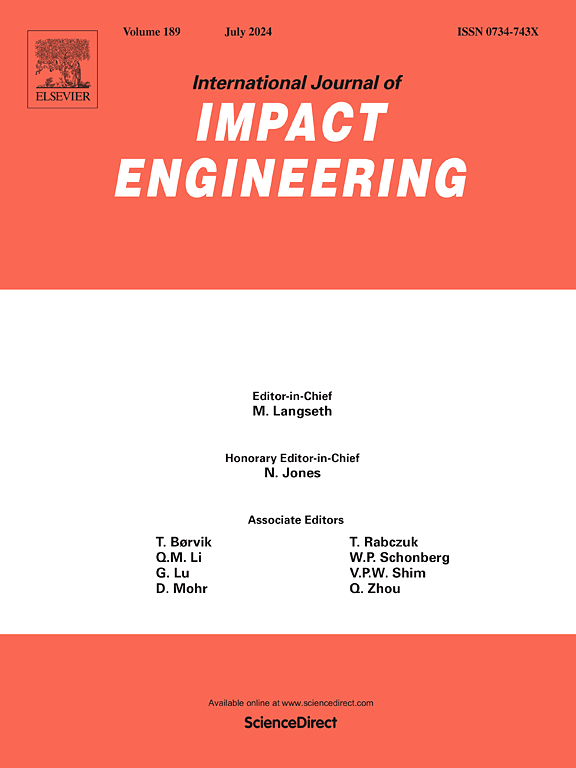Protective performance of sacrificial cladding with foamed geopolymer core under impact loading
IF 5.1
2区 工程技术
Q1 ENGINEERING, MECHANICAL
International Journal of Impact Engineering
Pub Date : 2025-04-25
DOI:10.1016/j.ijimpeng.2025.105372
引用次数: 0
Abstract
In the present study, a novel sacrificial cladding with a foamed geopolymer (FG) energy-absorbing core was proposed for structural protection to resist impact loading. First, the mechanical and energy absorption performance of FG was investigated through quasi-static and dynamic compressive tests. The test results demonstrated that an increase in density or strain rate would significantly enhance the energy absorption capacity of FG. Based on the test results, a phenomenological constitutive model of FG, considering the effects of density and strain rate, was proposed. Subsequently, the drop hammer impact tests were conducted on the monolithic steel panel (MSP, regarded as the protected structure) and the cladding-structure system (CSS) to evaluate the protective performance of the proposed cladding. The impact test results indicated that MSP exhibited a significant local indentation in its central region, while the monolithic steel panel in CSS primarily demonstrated a global bending deformation. In addition, with the numerical model validated by the impact test results, the effects of the impact loading area, initial impact momentum, and the FG core density on the protective performance of the proposed cladding were further numerically investigated. The numerical results demonstrated that, although the monolithic steel panel in CSS exhibited a slightly larger residual deflection compared to MSP in some cases, the sacrificial cladding still provided effective protection in terms of damage extent, energy absorption, and load transfer, especially under small impact loading areas or low initial impact momentum. It was noted that, due to the premature densification or limited deformation of FG, the sacrificial cladding with either low- or high-density FG cores led to more impact energy and a higher peak load transferred to the protected structure, demonstrating unfavorable protective performance. The results in the present study provided valuable references for the design and application of sacrificial cladding with FG core.
冲击载荷下发泡地聚合物牺牲包层的防护性能
本文提出了一种新型的牺牲包层,采用泡沫地聚合物(FG)吸能芯来保护结构免受冲击载荷的影响。首先,通过准静态和动态压缩试验研究了FG的力学性能和吸能性能。试验结果表明,密度或应变速率的增加会显著提高FG的吸能能力。在试验结果的基础上,提出了考虑密度和应变率影响的FG的现象学本构模型。随后,对作为防护结构的单片钢板(MSP)和包层-结构体系(CSS)进行了落锤冲击试验,评价了所提出的包层的防护性能。冲击试验结果表明,MSP在其中心区域表现出明显的局部压痕,而CSS的整体钢板主要表现为全局弯曲变形。此外,基于冲击试验结果验证的数值模型,进一步数值研究了冲击载荷面积、初始冲击动量和FG芯密度对所提复层防护性能的影响。数值结果表明,虽然在某些情况下,CSS中单片钢板的残余挠度比MSP略大,但牺牲包层在损伤程度、能量吸收和载荷传递方面仍然提供了有效的保护,特别是在较小的冲击载荷区域或较低的初始冲击动量下。结果表明,由于FG的过早致密化或变形有限,低或高密度FG芯的牺牲包层将导致更多的冲击能量和更高的峰值载荷传递给被保护结构,从而表明保护性能不利。研究结果为FG芯牺牲覆层的设计和应用提供了有价值的参考。
本文章由计算机程序翻译,如有差异,请以英文原文为准。
求助全文
约1分钟内获得全文
求助全文
来源期刊

International Journal of Impact Engineering
工程技术-工程:机械
CiteScore
8.70
自引率
13.70%
发文量
241
审稿时长
52 days
期刊介绍:
The International Journal of Impact Engineering, established in 1983 publishes original research findings related to the response of structures, components and materials subjected to impact, blast and high-rate loading. Areas relevant to the journal encompass the following general topics and those associated with them:
-Behaviour and failure of structures and materials under impact and blast loading
-Systems for protection and absorption of impact and blast loading
-Terminal ballistics
-Dynamic behaviour and failure of materials including plasticity and fracture
-Stress waves
-Structural crashworthiness
-High-rate mechanical and forming processes
-Impact, blast and high-rate loading/measurement techniques and their applications
 求助内容:
求助内容: 应助结果提醒方式:
应助结果提醒方式:


